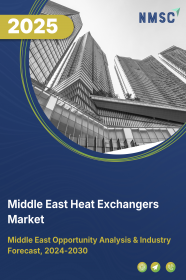
Middle East Heat Exchangers Market by Type (Shell & Tube, Plate & Frame, Air Cooled, and Others), by Material (Metals, Alloys, and Brazing-CLAD), and by End User (Chemical, Energy & Power, Heating, Ventilation, Air Conditioning, and Refrigeration (HVACR), Food & Beverage, Pulp & Paper, and Others)– Opportunity Analysis and Industry Forecast, 2024–2030
Industry: Retail and Consumer | Publish Date: 19-Dec-2024 | No of Pages: 118 | No. of Tables: 86 | No. of Figures: 51 | Format: PDF | Report Code : RC1569
US Tariff Impact on Middle East Heat Exchangers Market
Trump Tariffs Are Reshaping Global Business
Market Overview
The Middle East Heat Exchangers Market size was valued at USD 276.8 million in 2023, and is predicted to reach USD 523.4 million by 2030, with a CAGR of 8.9% from 2024 to 2030.
Heat exchangers are engineered devices utilized extensively across industrial, commercial, and residential sectors, including HVAC systems and refrigeration units, to facilitate efficient heat transfer between fluids without direct contact. They operate by enabling heat to pass through barriers such as solid walls or arrays of plates or tubes, performing various functions such as heating water in boilers or cooling air in air conditioning systems. Available in diverse designs tailored to specific needs, ranging from simple radiator coils to complex systems found in chemical processing plants and power generation facilities, they play indispensable roles across multiple industries and applications.
These roles encompass regulating air temperature in buildings, facilitating steam production in power plants, controlling temperatures during chemical reactions, and aiding in food processing, among others. Moreover, they are critical components in automotive cooling systems and are widely utilized in aerospace, marine, and wastewater treatment industries, contributing significantly to efficient thermal management and energy transfer.
Growing Industrialization and Urbanization in Middle East Drive Market Growth
The burgeoning industrialization and urbanization in the Middle East are key catalysts propelling market expansion within the heat exchangers industry. With the expansion of urban areas and the rise in industrial activities, there is an escalating demand for heat exchangers across diverse sectors, including manufacturing, construction, and residential developments.
Essential industries such as HVAC, chemical processing, power generation, and food processing rely extensively on heat exchangers for efficient thermal management and energy transfer. Moreover, the emphasis on energy efficiency and sustainable practices further fuels the adoption of heat exchangers in the rapidly evolving industrial landscape of the Middle East.
Stringent Government Regulations Regarding Energy Efficiency Boost Middle East’s Market Expansion
Stringent government regulations aimed at enhancing energy efficiency are pivotal in driving the market expansion of heat exchangers in the Middle East. With a determined focus on reducing carbon emissions and advancing sustainable practices, regulatory bodies in the region impose rigorous standards and policies across diverse industries.
These regulations incentivize businesses to prioritize investments in energy-efficient solutions, including heat exchangers, to curtail energy consumption and mitigate environmental impact. Consequently, the demand for heat exchangers in the Middle East is propelled by the imperative to adhere to these regulations, thereby fueling market expansion and facilitating the widespread adoption of sustainable technologies throughout the region.
High Installation and Maintenance Costs Restrain Market Growth
The Middle East faces significant barriers to market growth due to high installation and maintenance costs associated with heat exchangers. While these systems offer long-term benefits such as energy efficiency and enhanced performance, the initial investment required for their purchase and installation can be considerable.
Furthermore, ongoing maintenance expenses, including cleaning and repairs, contribute to the overall cost of ownership. These elevated costs discourage some businesses, particularly those with limited financial resources, from adopting heat exchangers, thereby constraining market expansion.
To overcome this challenge, manufacturers and policymakers may need to explore strategies aimed at reducing installation and maintenance expenses. This could involve incentivizing the adoption of energy-efficient technologies or introducing financial assistance programs to support businesses interested in investing in heat exchangers.
Integration with Renewable Energy Systems Creates a Market Opportunity
The integration of heat exchangers with renewable energy systems presents a notable market opportunity. With the rising demand for renewable energy sources such as solar and geothermal power, heat exchangers play a pivotal role in facilitating efficient heat transfer within these systems.
They are essential components in various renewable energy applications, including solar water heating, geothermal heat pumps, and biomass boilers, where they optimize energy efficiency and enhance system performance. The growing emphasis on sustainability and the shift towards clean energy sources further fuels the demand for heat exchangers integrated into renewable energy systems. This trend not only broadens the market for heat exchangers but also contributes to the overall expansion of the renewable energy industry.
Competitive Landscape
Several market players operating in Middle East’s heat exchangers market include Alfa Laval AB, Johnson Controls International plc, Carrier Global Corporation, Lennox International Inc., Trane Technologies plc, API Heat Transfer Inc., Kelvion Holding GmbH, Xylem Inc., Danfoss Group, and General Electric Company among others. These companies are adopting various strategies such as product launches to remain dominant in the heat exchangers market.
Key Market Segments
By Type
-
Shell & Tube
-
Fixed Tube Heat Exchangers
-
U-Tube Heat Exchangers
-
Floating Head Heat Exchangers
-
Other Shell & Tube Heat Exchangers
-
-
Plate & Frame Heat Exchangers
-
Gasketed Plate & Frame Heat Exchangers
-
Welded Plate & Frame Heat Exchangers
-
Brazed Plate & Frame Heat Exchangers
-
Other Plate & Frame Heat Exchangers
-
-
Air Cooled
-
Forced Draft Heat Exchangers
-
Induced Draft Heat Exchangers
-
-
Others
By Materials
-
Metals
-
Alloys
-
Brazing-CLAD
By End User
-
Chemical
-
Energy & Power
-
HVACR
-
Food & Beverage
-
Pulp & Paper
-
Others
REPORT SCOPE AND SEGMENTATION:
|
Parameters |
Details |
|
Market Size in 2023 |
USD 276.8 Million |
|
Revenue Forecast in 2030 |
USD 523.4 Million |
|
Growth Rate |
CAGR of 8.9% from 2024 to 2030 |
|
Analysis Period |
2023–2030 |
|
Base Year Considered |
2023 |
|
Forecast Period |
2024–2030 |
|
Market Size Estimation |
Million (USD) |
|
Growth Factors |
|
|
Companies Profiled |
10 |
|
Market Share |
Available for 10 companies |
|
Customization Scope |
Free customization (equivalent up to 80 working hours of analysts) after purchase. Addition or alteration to country, regional, and segment scope. |
|
Pricing and Purchase Options |
Avail customized purchase options to meet your exact research needs. |
KEY PLAYERS
-
Alfa Laval AB
-
Johnson Controls International plc
-
Carrier Global Corporation
-
Lennox International Inc.
-
Trane Technologies plc
-
API Heat Transfer Inc.
-
Kelvion Holding GmbH
-
Xylem Inc.
-
Danfoss Group
-
General Electric Company

















 Speak to Our Analyst
Speak to Our Analyst





















